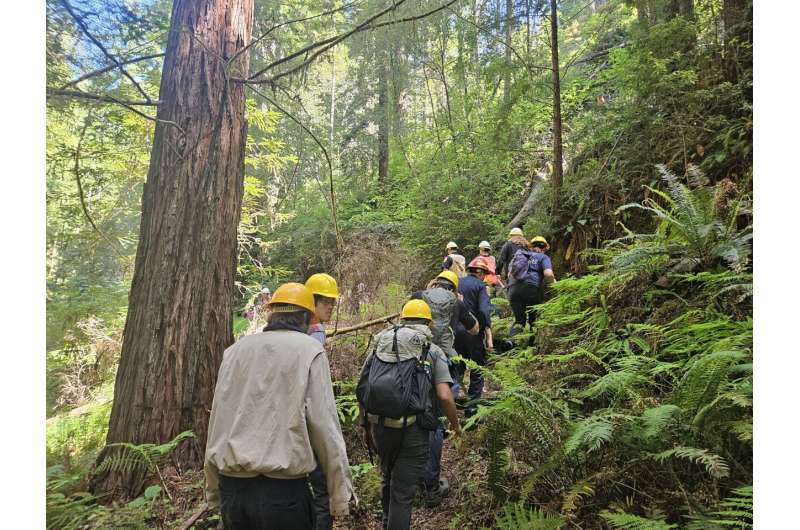This article has been reviewed according to Science X's editorial process and policies. Editors have highlighted the following attributes while ensuring the content's credibility:
fact-checked
trusted source
proofread
Protecting communities and watersheds through research in a redwood forest

Water trickles in a stream and redwoods tower overhead in Jackson Demonstration State Forest near Fort Bragg in Northern California. Joe Wagenbrenner, a research hydrologist with the U. S. Forest Service's Pacific Southwest Research Station, shares the story behind the scenery.
"Our scientific findings here help inform the regulation of the timber industry within state and private lands in California," Wagenbrenner states.
Over 30 of us listen intently. A diverse group from the U.S. Forest Service, CAL FIRE, Northern Arizona University, Cal Poly Humboldt, and other organizations, we've gathered to learn about, or in some cases, speak about research occurring here.
Experimental forests and watershed studies
Standing next to a fiberglass structure, Wagenbrenner explains how this flume controls the flow of the stream, so scientists can more accurately measure streamflow. Caspar Creek, he adds, has a South and North Fork, each divided into smaller sub-watersheds, allowing researchers to do paired watershed studies.
In these studies, researchers treat some areas and not others, so they can compare the results. In their latest experiment, they monitored several watersheds where logging up to 75% of trees occurred in the smaller parts of the South Fork.
"We're still analyzing the results of the current study. In addition to streamflow and sediment movement, we're looking at soil moisture changes, how much water trees are using, groundwater conditions, light availability, and understory regeneration across the range of harvest conditions," Wagenbrenner states.
A proud history and a tight-knit partnership
Research at the site dates back to 1961 when CAL FIRE joined forces with the Forest Service's Pacific Southwest Research Station to collaboratively manage the Caspar Creek Experimental Watersheds. Over 60 years later, that partnership is still going strong.
"When the state of California acquired Jackson Demonstration State Forest, they wanted to show it was still viable for timber production," Liz Keppeler, a hydrologist with the Pacific Southwest Research Station, adds.
In the 1970s, researchers removed trees from the South Fork for their first experiment. Removing the trees, especially those near watercourses, enhanced erosion and sent sediment into streams. Those findings informed California's forest practice rules, which evolve over time, as has the research.

After nearly 40 years in her role, Keppeler has witnessed management priorities change from focusing mainly on timber production to a more holistic approach. Today, in the grip of climate change, making forests more resilient is a priority.
"We work really closely with the Forest Service in the research we do," says Caitlin Grace an environmental scientist with CAL FIRE.
Protecting communities, redwoods, and watersheds
Even hardy, fire-adapted coast redwoods that can live for thousands of years are not immune to raging wildfires.
"Redwoods have thick bark and are high in tannins, which makes them naturally fire resistant. But their defense mechanisms may not be enough to survive with unprecedented climate change-driven fires we've seen recently," Grace adds.
CAL FIRE and research partners are using a combination of different fuel treatments, such as controlled burning, to see how the forest fares. They're assessing if cutting small trees before controlled burning helps reduce the fuels on the forest floor, and therefore, wildfire risk.
"These treatments will allow researchers to measure and compare different fire fuel mitigation methods for cost, vegetation change, wildlife use, as well as short- and long-term benefits," Grace emphasizes.
The partnership between CAL FIRE and the Forest Service is as interdependent as the health of the forest is to that of the watershed. CAL FIRE's work is particularly critical to supporting the Forest Service's Wildfire Crisis Strategy, which aims to sustain forests and protect communities. That fuel mitigation work also compliments the Forest Service's hydrology research at Caspar Creek.
"This research has informed California's regulations on protecting watersheds through streamside buffers, road design, and other rules. That's critical," Keppeler stated.
Provided by USDA Forest Service



















